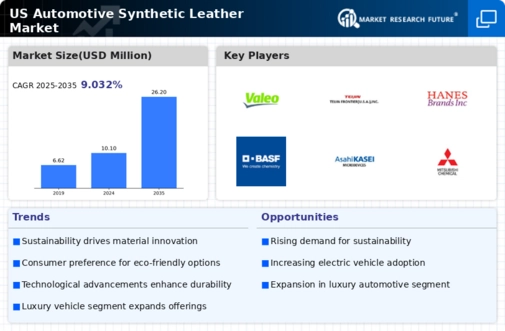The automotive synthetic leather market is currently characterized by a dynamic competitive landscape, driven by increasing consumer demand for sustainable and high-performance materials. Key players are actively engaging in innovation and strategic partnerships to enhance their market positioning. Companies such as BASF (US) and DuPont (US) are focusing on developing eco-friendly synthetic leather alternatives, which aligns with the growing trend towards sustainability in the automotive sector. Meanwhile, Lear Corporation (US) is leveraging its expertise in advanced materials to create lightweight and durable synthetic leather products, thereby enhancing vehicle performance and comfort. These strategies collectively contribute to a competitive environment that emphasizes innovation and sustainability as primary growth drivers.
In terms of business tactics, companies are increasingly localizing manufacturing to reduce lead times and optimize supply chains. This approach not only enhances operational efficiency but also allows for greater responsiveness to market demands. The competitive structure of the market appears moderately fragmented, with several key players exerting influence over various segments. The collective actions of these companies suggest a trend towards consolidation, as they seek to strengthen their market presence through strategic collaborations and acquisitions.
In November 2025, BASF (US) announced the launch of a new line of bio-based synthetic leather, which is produced using renewable resources. This strategic move is significant as it positions BASF at the forefront of the sustainability trend, appealing to environmentally conscious consumers and automotive manufacturers alike. The introduction of this product line is likely to enhance BASF's competitive edge and market share in the automotive sector.
In October 2025, Lear Corporation (US) entered into a partnership with a leading electric vehicle manufacturer to supply advanced synthetic leather for their upcoming models. This collaboration underscores Lear's commitment to innovation and its ability to adapt to the evolving needs of the automotive industry. By aligning with a forward-thinking manufacturer, Lear is poised to capitalize on the growing electric vehicle market, which is increasingly prioritizing sustainable materials.
In September 2025, DuPont (US) expanded its production capabilities for synthetic leather in North America, investing $50 million in a new facility. This expansion is indicative of DuPont's strategic focus on meeting the rising demand for high-quality synthetic materials in the automotive sector. By increasing its production capacity, DuPont aims to solidify its position as a leading supplier and enhance its ability to serve a diverse customer base.
As of December 2025, the automotive synthetic leather market is witnessing trends that emphasize digitalization, sustainability, and the integration of AI technologies. Strategic alliances are becoming increasingly important, as companies recognize the value of collaboration in driving innovation and enhancing supply chain reliability. The competitive landscape is shifting from traditional price-based competition to a focus on technological advancements and sustainable practices. This evolution suggests that future differentiation will hinge on the ability to innovate and deliver high-quality, sustainable products that meet the changing preferences of consumers.




















Leave a Comment